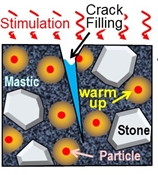Quest for improving service life of asphalt roads
DOI:
https://doi.org/10.21809/rilemtechlett.2019.102Keywords:
Asphalt, Roads, Innovation, Research, Service lifeAbstract
Selected results and initiatives in modern asphalt pavement research for increasing service life of asphalt pavements under the aspect of sustainability and multifunctional use of roads are summarized. Focus lies on innovative approaches and own experience, jointly elaborated during the last decades within the road engineering/sealing components lab at Empa and both the highway/railways engineering and building materials group at KTH. This includes material concepts and design as well as pavement system and construction aspects from an experimental and modelling point of view. It includes also the application of powerful experimental and computational tools, such as Atomic-Force-Microscopy (AFM), X-Ray-Computer-Tomography (CT), Digital-Imaging-Correlation (DIC) and Discrete-Element-Method (DEM). As for materials, recycling issues and the use of Phase-Change-Materials (PCM) or metallic ingredients for inductive thermal crack healing are addressed. In order to remind that material design must also account for the workability during the process of compaction, the new Compaction-Flow-Test (CFT) developed at KTH is shortly presented. Innovative ideas for structural material composition are also mentioned, such as “artificial aggregates” or “additive manufacturing”, being aware that there is still a long way to go. Regarding pavement systems, ideas for multifunctional road applications are proposed. Focus is also put on special issues, such as construction joints.

Downloads
Published
How to Cite
Issue
Section
License
Authors retain copyright of the articles published in RILEM Technical Letters and grant the journal the right of first publication with open access. The work is simultaneously licensed under Creative Commons Attribution 4.0 International License (CC BY 4.0) that allows others to share and adapt the work under the following terms: 1) a proper attribution is given in a form of bibliographic record with the DOI link directing to RILEM Technical Letters; 2) a link to the license is provided; 3) the changes (if any) are indicated.









